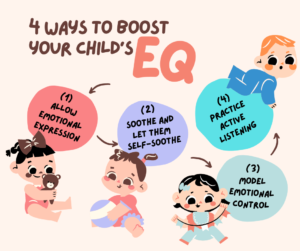Four Ways to Boost Your Child’s EQ
Mindful strategies for strengthening emotional intelligence

If you’re on our page, we know you’re looking at boosting your child’s joy through engagement, play, and enrichment. One of the best ways to promote your child’s well-being and success over time is to boost their EQ, or emotional intelligence. In fact, emotional intelligence is swiftly becoming one of the trending factors in hiring, so not only are you training them for the present, you’re preparing your kiddo for the future. There are many ways to train EQ, but here are four we recommend.
(1) Allow Emotional Expression
Children will often act out their emotions in volatile ways (aggression), repress their feelings, or, if we are giving them the proper space, express their feelings. It’s important to let your child feel what they’re feeling. Don’t try to fix it, don’t ask them to change their feelings—allow them to feel what they’re feeling, validate it, and let them get it out.
A good example of phrasing is “I see that you’re feeling sad. It’s ok that you’re feeling sad; we all do sometimes. Tell me about it.”
(2) Soothe and Let Them Self-Soothe
Most children, and even teens, are still learning how to cope with their feelings. Use times of emotion as an opportunity to both soothe them and let them learn to soothe themselves.
(3) Model Emotional Control
One of the most important ways children learn is through modeling (see Bandura’s social learning theory), so making sure you’re demonstrating appropriate emotional regulation is key to their future emotional success. That means showing them how you soothe strong emotions, considering the consequences of those emotions, and acknowledging them in the moment. Your children learn when they see you working through volatility effectively.
(4) Practice Active Listening
You don’t have to agree with what your children are feeling or even think it’s appropriate at that moment. However, by demonstrating that you see that feeling and recognize it (validation), you open the door to active listening, which will develop your relationship and the trust your children have in you as a safe space. Remember, reflect the feeling and validate the emotion, and check that you’re getting it right (“What I’m hearing is that you feel angry because you didn’t get to do that activity. Am I getting it right?”)
By practicing these four techniques, your child will be ready to conquer a variety of settings, experiences, and challenges. We look forward to seeing your EQ QTs this summer!
Looking forward to seeing your readers soon!





